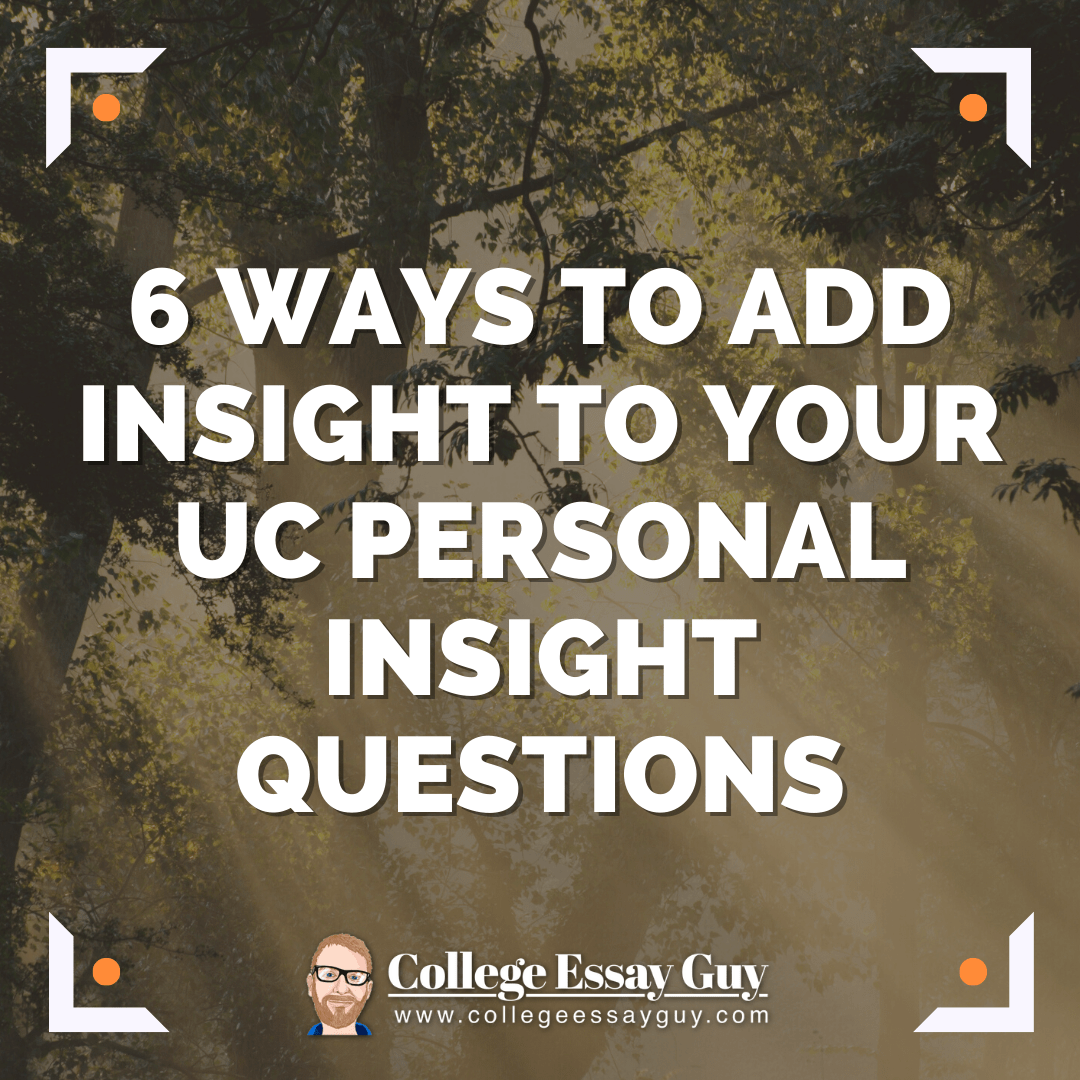Before we begin, what exactly is … insight?
Essentially, insight is your answer to the question: “So what?” What are the lessons your experiences have taught you? What are the connections you’ve made? Why do these things matter to you?
The clearest way to answer these questions is to reflect on the values you’re showing in your writing. What have you learned about them?
For example, in PIQ example 1 here, the author spends some time at the end of the essay reflecting on how their experiences have shaped them:
I’ve learned to maximize my strengths and not try to conquer everything. Moreover, I’ve learned to be responsible with my choices. A wrong argument can mean losing if we can’t defend well. Not only do I now know how to zoom in from a bigger picture, but I also know how to pick the right place to zoom in to so I can achieve my goal.
Below, you can explore a few specific ways to add insight to your PIQ.
1. Try to think of the opposite.
How it works: Opposite of what? The opposite of whatever you were initially thinking of as a potential insight—this can be a way to avoid more common or cliché reflections.
Examples:
Instead of saying, “I learned that my body is capable of more than I’d originally thought,” maybe you learned that you’d been pushing your body too hard and you actually needed more rest than you knew.
Notice how this focuses on a new value: rest or self-care.
Instead of saying, “I learned that clarity and decisiveness were key,” maybe you discovered that sometimes it’s valuable to sit for a while with ambiguity and not having the answer.
2. Try shifting from one value to another.
How it works: Maybe you start talking about one value … but by the end of the sentence, you’re talking about another one. Here are a couple examples to show you what I mean:
Security → Adventure: I learned that, in my desire to keep things stable, I’d actually been playing it a little safe and what I needed in my life was a little more adventure.
Honesty → Kindness: I learned that, in some cases, being completely honest isn’t always useful—or kind—and that timing and tone are key.
3. Redefine a value.
How it works: Pick one of the values and define it in a less common way. For example:
I realized “community” was more than the people whose names I knew—it was the bus driver I’d say hello to each morning, the street cleaner I’d never met, even my neighbors’ pets were part of my extended community.
Or:
I realized that “leadership” didn’t really mean simply seeing what I thought was the best course of action for people to take and pushing them to take it; instead, real leadership involved making myself obsolete—creating space for people to step into and lifting up those I was leading until they no longer needed me.
This approach to insight/reflection can be nice because it necessitates getting into some nuance. Here’s a quick exercise to explore this approach:
Pick a couple of the values that you’re demonstrating in your body paragraphs.
Think of more common/cliché definitions for these values.
Don’t use those.
Experiment with defining those values in ways that get into nuances people seem to often overlook.
Another way to think of this: People often make broad/grand statements about values. Those broad/grand statements will often contain kernels of truth, but will also be wrong in that they are simplistic and overlook things. What are they missing?
4. Connect to something we totally didn’t expect (but just briefly).
How it works: Link the experience or detail you’re discussing to something that it has a justified connection to, but that we (your audience) probably weren’t thinking you were going to bring up.
Read this excerpt from the “Robotics Club” essay:
As an introverted leader, I try to listen first, and use my soft-spoken attentiveness to invite dialogue that improves team chemistry. With this ability, I have learnt to control the momentum of official debates and basketball matches. Thus, whether my team wins or loses, the external pressure of either suffering a setback or enjoying an achievement rarely affects my team's composure, which helps us maintain our consistency and resolve.
Why this example works: Here, the author does a nice job of connecting leadership in robotics to debate and basketball, exploring how insights from the former have influenced his understanding of and actions with the latter.
5. Drop in a (possibly surprising?) connection to either a) your career or b) your future ambitions.
If you’re unsure how to end your PIQ, one option is to segue to your career or future ambition.
Important note: This can be nice, especially in the UC #6 (Academic Subject) PIQ, but you definitely don’t have to do this.
Quick example of mentioning career:
Most importantly, yet ironically, art history piqued my interest in STEM fields. Previously, I did not see the point in studying and solving an endless array of numbers, only to produce another number. However, I now understand the importance of STEM for advancing future civilizations and preserving ancient ones. I learned to ask questions, such as “Which chemicals in certain mediums allowed some art to be preserved, but others destroyed like Da Vinci’s The Last Supper?” and “Why aren’t more houses ecologically-built like Fallingwater?”
To read this whole PIQ, click here.
But you don’t have to name your career specifically—you could keep it a bit more open-ended.
Quick example of mentioning future ambitions (but not a career) from the “Robotics Club” PIQ:
As I visualize myself building projects with a group of coders in the future, I believe that my discreteness, experience in robotics, practical tenacity and absolute love for innovating technology will be vital for all my endeavors.
To read this whole PIQ, click here.
6. Realize you were wrong about something.
How it works: Just like it sounds. Set up a misconception you had, then show us how you’ve grown and identify the insights you’ve gained by discussing your new understanding.
For example: “I realized that in searching for others’ approval, I had given away my autonomy, and that if I wanted to live a truly free life, I had to respect other people’s right to an opinion, but not live by them.”
Or: “I had thought of vulnerability as showing weakness. Now I realize that was just my discomfort speaking, and that being vulnerable with someone takes true courage and is one of the best ways to build connection.”
Here’s a nice example from a past student’s PIQ:
In time, I found the key to improvement wasn’t a decisive plan. Rather, it was experimentation and iteration. I’d make a decision, and then remake it because I wasn’t even close. Problem solving is often assumed to be clean and algorithmic, but my most effective solutions were malleable and messy—not to mention produced in a chain of modifications so convoluted as to elude any sense of monolithic inspiration. And to be fair, I don’t recall experiencing any “magical lightning bolts of creativity” in which the perfect machination was unveiled in its entirety. But that wasn’t necessary. My innovation was incremental, and it was holistic. Behind every idea were its predecessors, and ahead, its execution. To me, that is the heart of creativity. As long as I was willing to be proven wrong, a new idea was within reach. And with it, came endless, autocatalytic possibilities, all competing to push me in a new direction.
To read this whole PIQ, click here.
7. Teach us to see something simple in a new way. (or) Show us how something seemingly simple … actually isn’t.
How it works: This can be a nice technique for taking something that may be common or seemingly mundane and adding complexity and value to it (and, thereby, to your PIQ) by showing how it has some hidden depth.
For example: “While for some people jeans may just be a reliable pair of pants, for me, knowing their history, they represent fashion’s ability to speak about class in America.”
Here’s a nice one from a student who wrote about working in construction:
Working in construction has made me feel like a bigger part of society, because I’m shaping the buildings and offices my community uses. Although I don’t make the choices in design, my workmanship is reflected in every job I’ve done. Because of this, my most memorable projects are those that I’ve taken on by myself.
It has been a personally fulfilling experience--there’s just something about peeling away the last strip of tape off a new floor that’s indescribable--and getting to see hours of planning, preparation, and work come together is such a rewarding experience. The best part? Knowing that some family will get to enjoy my work.
To read this whole PIQ, click here.
Or, a variation: Show us a surprising connection or balance between values.
For example:
I believe that to achieve efficiency and productivity in the working environment between employees and the manager, it requires not only the firmness and attention of a boss, but also the empathy and vision of a leader.
We’re probably not surprised at all by efficiency and productivity being linked to something like firmness. That seems fairly simple or standard. But the fact that empathy might be a useful tool for a manager is less simple or obvious, and shows some nice reflection.
Next steps
Spend some time identifying the different values you’re demonstrating in your body paragraphs. Then, try using some of the above techniques to strengthen the insights related to those values in your PIQs.
Additional Resources:
Andrew has worked as an educator, consultant, and curriculum writer for the past 15 years, and earned degrees from Stanford in Political Science and Drama. He feels most at home on mountain tops and in oceans.
Top Values: Insight/Growth | Truth | Integrity











